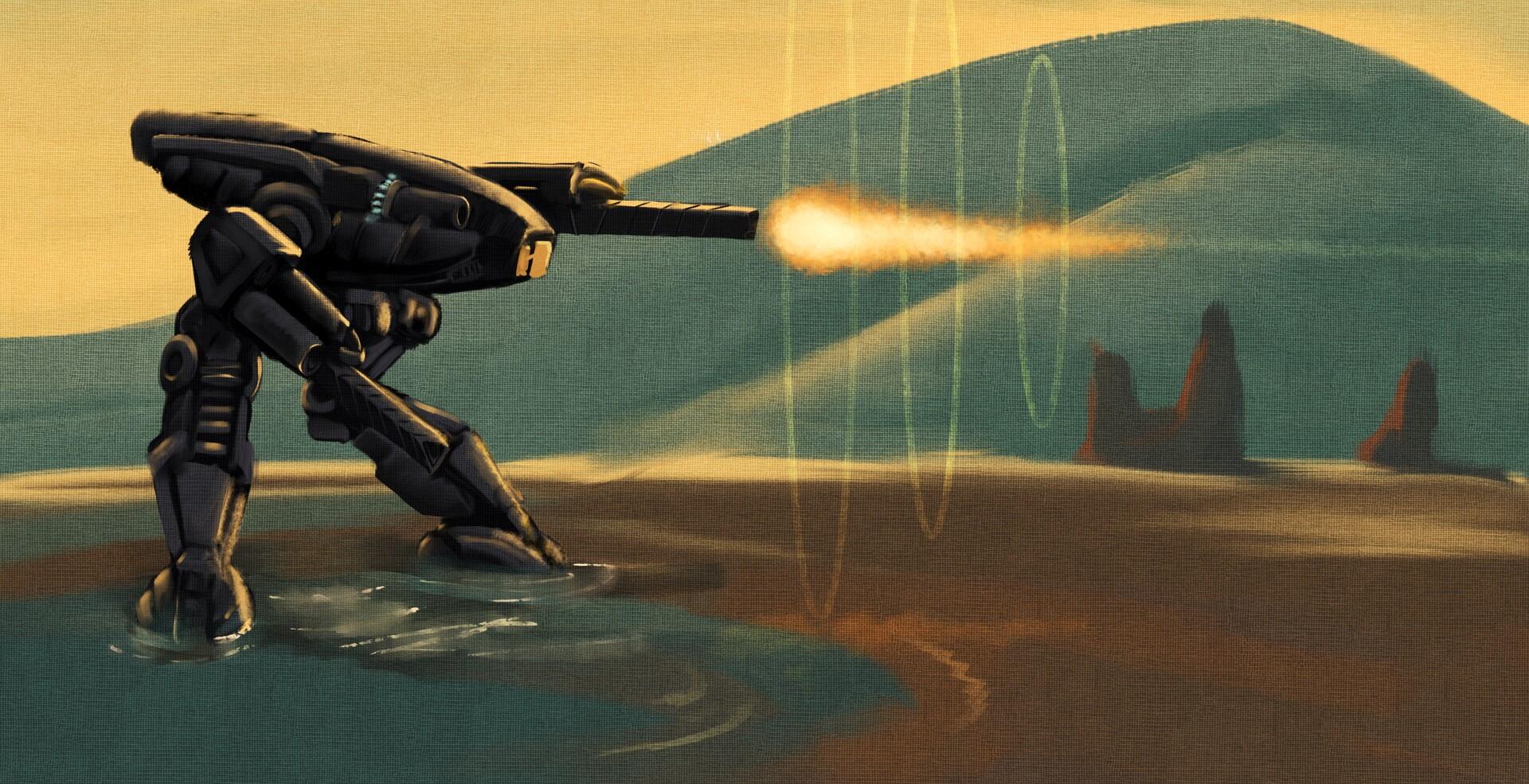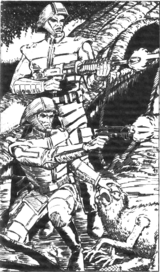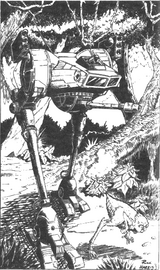Tetatae

Featured in the novel Far Country, the Tetatae are the only intelligent species of aliens making a canonical appearance in the fictional BattleTech universe.
Contents
Canonicity and controversy[edit]
Many fans feel that sentient aliens should have no place in BattleTech fiction, and refuse to acknowledge the Tetatae's existence accordingly or challenge their canonical status. Quotes from the ship's crew stating that the protagonists are marooned "not anywhere that's real" and could be in a "parallel universe", though unreliable and merely admitting from the context that they have no idea in which star system they are, are sometimes used to argue that the Tetatae are in fact not part of the BattleTech universe proper.
The Line Developer's official stance is that technically, the novel Far Country is fully canonical, as are the Tetatae featured in the story. However, it has also been made clear that sentient aliens are considered incompatible with the BattleTech aesthetics and that aliens, particularly the Tetatae, will not be revisited in the fiction. Further references to the Tetatae are deliberately avoided. Their homeworld appears to be beyond any area of space known or accessible to humankind; it was only ever reached twice by human JumpShips through accidental and fatal misjumps, and there is no known way to leave the system again. This conveniently keeps the Tetatae separated from the rest of the BattleTech universe for good.
(It should be noted that there is one other possible instance of sentient aliens, the Swamp people, but they only appeared in passing in an inconsequential scene in an early novel. Their behavior and technology are primitive enough to call into question whether they are truly intelligent or sentient.)
Appearance[edit]
The Tetatae are native to the Earth-like planet Kaetetôã in an unknown star system. They resemble large flightless birds with arms, standing approximately one and a half meters tall. Male and female Tetatae exist, but seem to have a very similar physical appearance.
The long, ovoid body is covered in iridescent feathers (also described as rich downy hair). While the hair is described as brown at one point, the Tetatae have the ability to change the color of the feather roots which were observed to change color between green and purple, although other colors including yellow and blue are depicted on the book cover. The iridescence was observed to fade to an ashen hue on a wounded specimen. Two pairs of forward-reaching toes are matched by a rear-facing toe for a total of six toes on each foot; a similarly built but smaller pair of appendages serves as arms and hands. The lower legs have broad, webbed phalanges above the claws, well suited for the swampy terrain of their habitat. Both sets of "feet" and "hands" are completely articulated and capable of grasping and manipulating objects independently, giving the Tetatae considerable dexterity; they can dismantle, move, and reassemble human equipment with far greater speed and efficiency than humans could. A notable feature are the Tetatae's elongated eye slits extending from the side of the skull to the front. Each of the two red eyes, set some 20 centimeters apart, has two pupils, one usually facing forward and one sideways.
In one instance, a human trooper noted the warmth of a (wounded) Tetatae's hand, which could be the body temperature or a feverish body reaction to injury. Tetatae blood is clear yellow.
Tetatae can shut down part of their body while the other part remains alert. This method of resting half of their body gives them exceptional endurance and allows them to hold council sessions in excess of 18 hours.
The average Tetatae lifespan is around 200 years. At one point an infant Tetatae, approximately one year old, is described as a walking "little ball of fluff".
Tetatae communicate orally with a clacking language and are also capable of human speech, although their voice is described as high and chirping, with strength on the hard sounds.
Members of the Vost Lance demonstrated that Tetatae are edible for humans, claiming they "taste a bit like chicken".
History and culture[edit]
Relying exclusively on memory and long-winded oral tradition, the Tetatae as of 3056 had no written language and no historical records. According to history as recalled on their council, the Tetatae originally lived on the plains bordering on the great river to the west. Their culture stagnated, and eventually they divided into two groups, one remaining on the plains while the other moved into the rainforests where they found life to be easier, advanced to a slightly higher level of technology, built log huts, and fostered the Tetatae religion.
Besides splitting up into plains dwellers and forest dwellers, the arrival of humans seems to be the single most important event in Tetatae history. They were able to pinpoint the first arrival of humans to their planet to roughly 500 years ago. (Although this is not known to the characters in the novel, the exact year was 2510, i.e. 546 years ago at the time.) When the humans first fell from the sky, they had dealings with the plains dwellers who tried to help them. Many plains dwellers were killed, until the humans found that the Tetatae could speak; then they enslaved and exploited them and also fought among themselves. The Tetatae in the human settlements were treated so poorly that several slave revolts occurred in which the humans executed large numbers of Tetatae. Considering the humans overall bad, the forest dwellers elected to avoid contact with them.
When another group of humans arrives five centuries later with BattleMechs, the Tetatae immediately associate the birdlike Locusts with their reverse-joint legs with their own species, while the other, humanoid 'Mechs (a Javelin, a Panther and a Phoenix Hawk LAM) are associated with the humans. Subsequently, they flock to the faction operating the two Locusts when the humans begin to fight among themselves, regarding the Locust-faction under Sho-sa Yubari Takuda as angelic or divine beings to restore the order that the other humans have upset.
Cultural organization[edit]
The peaceful nomadic Tetatae species is divided into tribes of forest dwellers and more primitive tribes of plains dwellers. Human settlers have taken Tetatae from the plains into their cities for menial tasks in what amounts to slavery, arguable creating a third group accustomed to a human technology level above their own (even though the human colonies on the planet rely on eighteenth-century technology such as steam power by 3056).
The Tetatae lifestyle is somewhat communistic. Although they maintain fields, they make little use of domesticated plants and none of animals, harvesting the natural abundance. There is little private property among Tetatae, and they find the human concept of land ownership and territories incomprehensible. Similarly, they are not used to the concept of violence or fighting; the usual Tetatae approach to a localized problem is to avoid it and move elsewhere.
Within a Tetatae tribe, the twelve oldest specimen (of either gender) form the central council, the circle of elders, presided over by the hetman.
If a tribe grows too large, it is broken up into two bands by the council, a rare event occurring perhaps about once in three centuries.
Religion[edit]
Tetatae believe in a godly being, which they are convinced resembles their form, and in an afterlife. They have a concept of good and evil, with "good" actions thought to affect the afterlife. Service for the tribe is regarded as "good". Death and burial rites are important to them.
Other[edit]
Although it sounds Latin, the origin of the name of the Tetatae species is unknown and might stem from their own language.
The planet name Kaetetôã is taken from the Tetatae language, literally translating as "earth and sky".
Tetatae consider fruits from plants with four-pointed leaves hurtful and will not eat them. It remains unclear if they are actually poisonous for Tetatae.
Named Tetatae individuals[edit]
- Daeka (m) - Guide
- Dakodo (m) - Leader of a small forest tribe. First one to make contact with the newly arrived humans in 3056; he becomes Sho-sa Yakuda's liaison contact, translator and spokesman to the Tetatae.
- Díkáká - Predecessor of Totito as hetman
- Dokaepi - Tribe shaman and spiritual leader
- Kâeto (m) - Second-most junior council member; first one to imply that violence should be taken against the humans, a previously unheard of concept for which the Tetatae do not even seem to have a word
- Kaotôt - Guide
- Kátêo - Predecessor of Díkáká as hetman
- Pikaete (m) - Wizened city dweller
- Pita (m) - Self-appointed man-servant to Sho-sa Takuda
- Põpae (f) - Successor/stand-in for Dakodo on the council
- Potáet - Guide
- Tatádî (m) - Têkã's predecessor on the council
- Têkã (f) - Dakodo's predecessor on the council
- Têopõ (f) - Daughter of Pikaete; militia volunteer and informant
- Topi (f) - Guide
- Totito (m) - Hetman
Notes[edit]
- Late on 31 March 2021 (so that it was already 01 April for some fans), former Line Developer Herb Beas started an unofficial and strictly private, i.e. noncanonical, story titled Far No Longer in the fan fiction section of the BattleTech Forum. The story turns the original premise on its head: A misjump to Pleione amidst ongoing fighting in 3153 brings a human mercenary force to a deserted world which is discovered to apparently be Pleione some 5000 years in the future. It is discovered that Tetatae empires have colonized the former Inner Sphere long since; humans seem to have wiped themselves largely out and what remains of them are reservations of low-tech humans living without space travel technology on a small handful of worlds, supervised by an advanced Tetatae civilization with Tetatae versions of BattleMechs, power armor, and "Warpships" that functionally serve as JumpShips but seem to work differently.
Bibliography[edit]
- Far Country (novel)




